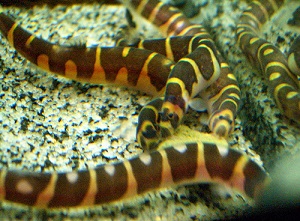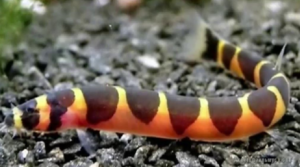

The Kuhli Loach (Pangio kuhlii) is a small eel-like freshwater fish belonging to the loach family. They are a bottom-dwelling, brightly coloured fish that might hide under aquarium decorations in the bright lighting of an aquarium. This snake-like creature is nocturnal. A scavenger in the wild, I never notice them eating at feeding times, yet rarely do we lose them as they are quite hardy. When grown to full size they are an impressive looking fish.
Common Name(s) : Kuhli Loach, Kuhlii Loach, Coolie Loach
Family : Cobitidae
Genus: Pangio
Species : Pangio kuhlii
Origin : Indonesia and the Malay Peninsula
PH : 5.5 – 7.5
Hardness : Soft to Moderate
Temperature : 24 – 30°C / 75–86ºF
Maximum Size : 10cm / 4″
Lifespan : 10-14 years
Aggression Level : Peaceful (1/10)
Recommended Tank Size : 20 Litres +
Strata : Bottom Dweller
TANK SET UP
In the wild, the Kuhli Loach natural habitat is the sandy beds of slow-moving rivers and clean mountain streams. They are a social fish and are typically found in small clusters (they are not schooling fish but enjoy the company of their species) but are cautious and nocturnal by nature and swim near the bottom where they feed around obstacles.
In the aquarium choose a fine substrate of sand or 3mm gravel and offer cover for a bit of shade. Cover may involve some live or fake plants, rocks or driftwood. All up however, Kuhli Loaches arent very fussy, I find them quite robust.
SUITABLE TANK MATES
Angelfish | Barb | Betta | African Cichlids | American Cichlids | American Dwarf Cichlids | Bristlenose Catfish | Corydorus Catfish | Tandanus Catfish | Other Catfish | Danios | Whiteclouds | Medakas | Discus | Eels | Flying Fox | Common Goldfish | Fancy Goldfish | Dwarf Gouramis | Large Gouramis | Gudgeons | Guppies | Killifish | Loaches and Botia | Mollies | Murray Cod | Oscars and other large Cichlids | Silver and Golden Perch | Plants | Platys | Rainbowfish | Rasbora | Saratoga | Sharks | Silver Dollar | Shrimp / Yabbies / Crabs | Snails | Swordtails | Tetras
DIET
Omnivores, Kuhli loaches are scavengers, so they will eat anything that reaches the bottom. They usually feed at night, but can be taught to feed in the day in the home aquarium.
SEXING AND BREEDING
Male Kuhli Loaches have a more leaner body in contrast to the females body that takes on a more plumper appearance. Additionally, the pectoral fins of the males are noticeably bigger and more paddle-shaped as well as being more likely to be pigmented to some degree, in contrast to the females.
Kuhli Loaches are sexually mature at about 7cm or roughly 12 to 18 months old. In the wild, the fish spawn communally in very shallow water. In an aquarium, breeding in captivity requires plenty of hiding spaces and consistent water quality.
When breeding, the females often become larger than the male and their greenish ovaries can be seen through the skin before spawning. Condition the loaches on some frozen bloodworm or similar over a couple of weeks whilst over the same period reduce water PH to a level of 6.5 by adding small amounts of PH down.
Kuhli Loaches spawn as pairs, but it’s best to get a group of adults, and let them pair off and select their own mate. Spawning is not easy, but when it occurs a few hundred greenish eggs are laid among the roots of floating plants like wisteria, java moss, water lettuce or even duckweed. Males begin courtship by mouthing the vents of the female. The couple will entwine, then find appropriate plant cover in which to spawn. Groups may spawn together, or they may pair up separately.
Adults may consume eggs after spawning.
OTHER USEFUL INFORMATION
The kuhli loach is an eel-shaped fish with slightly compressed sides, four pairs of barbels around the mouth, and very small fins. The dorsal fin starts behind the middle of the body, and the anal fin well behind this. The eyes are covered with a transparent skin. The body has 10 to 15 dark brown to black vertical bars, and the gaps between them are orange to yellow with a light underside.
The kuhli loach is a bottom dweller that burrows into soft places. Its older generic name ‘Acanthophthalmus’ comes from the meaning ‘thorn’ or ‘prickle-eye’, after a spine beneath each eye.
This fish can live for up to 14 years.
